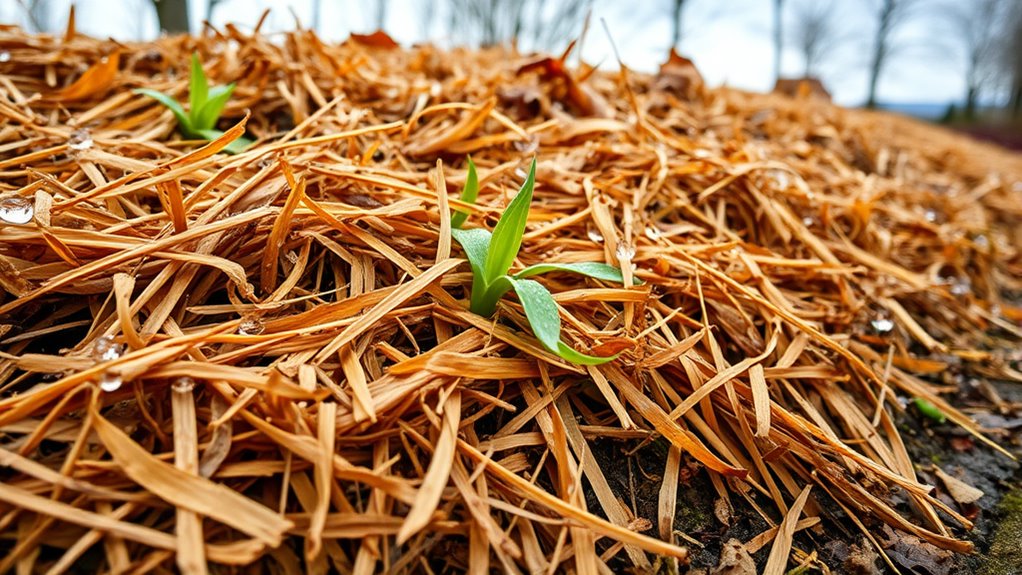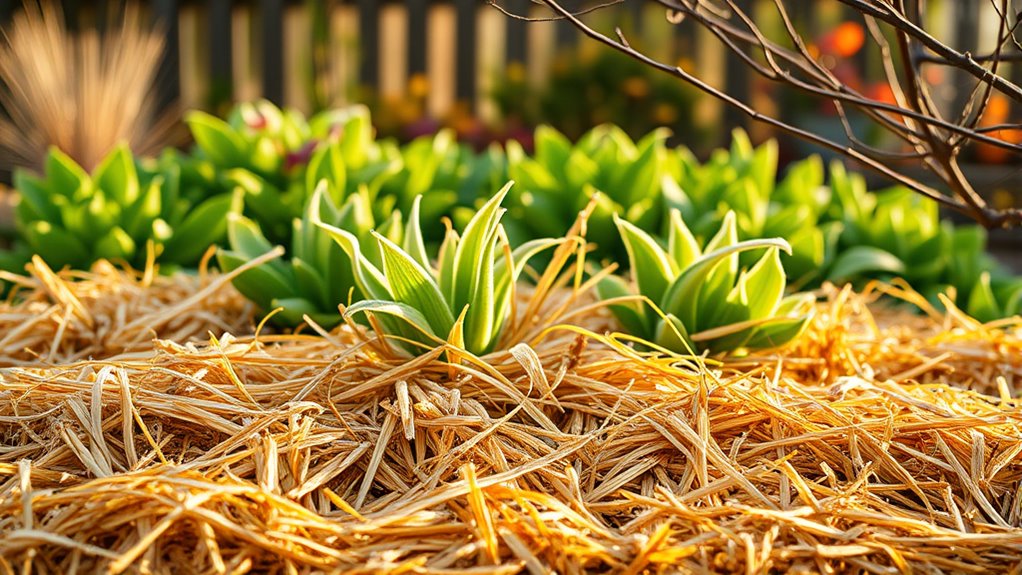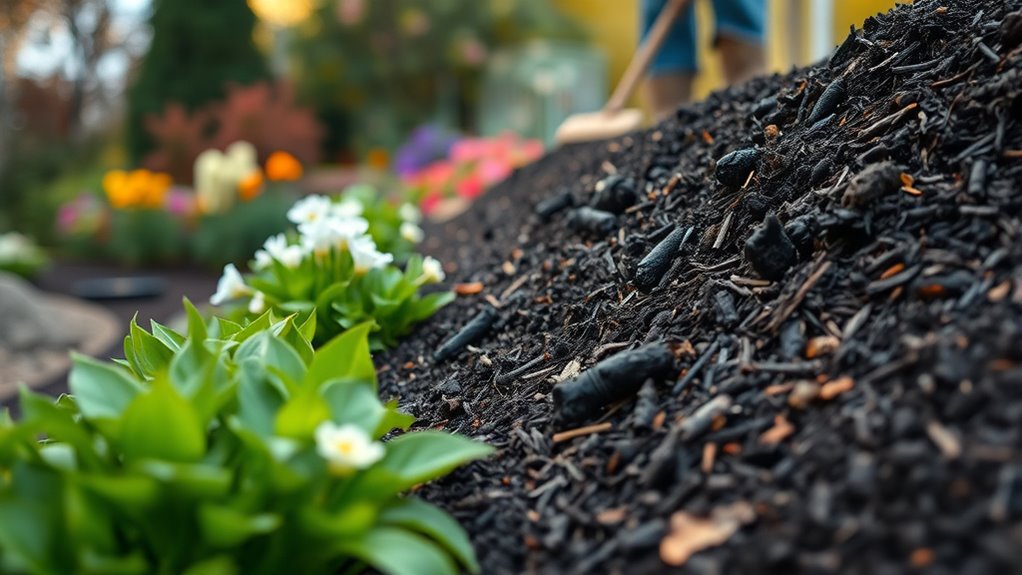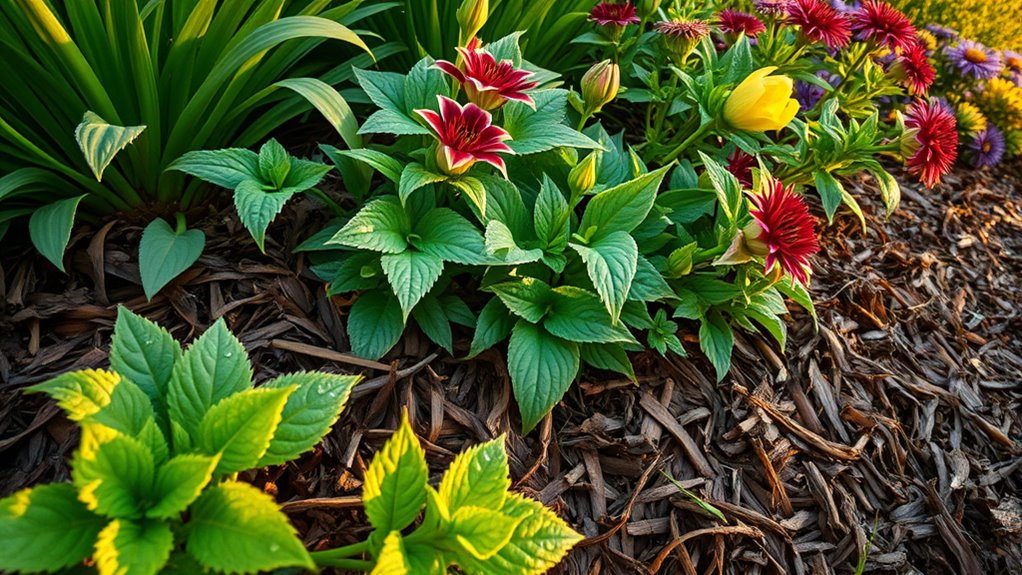To safeguard your perennial beds before the first frost, apply a 2-3 inch layer of organic mulch like shredded bark or straw when the soil is slightly moist, usually in early fall. Make sure to clear away debris, remove dead plants, and loosen the soil first. Spread mulch evenly, keeping it slightly away from plant crowns to prevent rot. For tips on perfect timing and techniques, keep exploring to guarantee your plants stay healthy all winter.
Key Takeaways
- Apply mulch in early fall when soil is slightly moist, before the first frost, to protect roots.
- Use 2-3 inches of organic mulch like straw or shredded bark for insulation.
- Remove dead plant material and weeds before mulching to prevent pests and diseases.
- Loosen soil surface to promote water penetration and root growth beneath the mulch layer.
- Keep mulch slightly away from plant crowns to prevent rot and ensure proper air circulation.
Timing Your Mulching Application

Timing your mulching application is crucial to guarantee your perennial beds thrive. The right timing ensures soil moisture stays consistent, preventing dehydration or over-saturation. Typically, you should mulch when the soil is still slightly moist but not wet, usually in early fall before the first frost. Applying mulch too early can trap excess heat and moisture, risking rot or pest issues. Waiting too long leaves roots vulnerable to cold damage. Aim for a mulch depth of about 2 to 3 inches; too thick can suffocate plants, while too thin offers little protection. Regularly assessing soil moisture levels can help determine the ideal moment. Proper timing and mulch depth work together to insulate roots, conserve moisture, and promote healthy growth through the colder months. Ensuring your mulch is appropriately placed helps maximize its benefits and supports overall plant health.
Choosing the Right Mulch Materials

Selecting the right mulch materials is essential for protecting your perennial beds effectively. You want a mulch that provides good soil insulation, helping keep the ground warmer during freezing temperatures. Organic mulches like straw, shredded bark, or composted leaves are excellent choices because they break down gradually, enriching the soil while insulating it. These materials also improve moisture retention, ensuring your plants don’t dry out during cold spells. Avoid using materials that compact easily or repel water, such as plastic or heavy gravel, as they reduce soil aeration and moisture absorption. Choose mulch that’s appropriate for your climate and aesthetic preferences. Properly selected mulch will shield your perennials from frost damage, maintain consistent soil temperatures, and promote healthy root development. Additionally, selecting mulch materials that are biodegradable ensures they will decompose naturally, adding organic matter back into the soil over time. Using local materials can further enhance the mulch’s effectiveness and sustainability. Selecting mulch with good insulation properties can make a significant difference in protecting your plants during harsh winter conditions. For optimal results, consider incorporating moisture-retentive mulches to further safeguard your perennials from drying out during cold weather. Furthermore, considering vacuums for pet hair can help keep your garden tools clean and free from debris after mulching.
Preparing Your Perennial Beds for Mulching

Before applying mulch, it’s important to prepare your perennial beds properly to guarantee the mulch functions effectively. Start by removing any dead or diseased plant material to reduce pests and improve soil aeration. Loosen the soil surface gently to promote healthy root growth and better water penetration. Check for pest activity and address issues early, as mulching can hide pests. Use the table below to guide your preparation:
| Step | Purpose |
|---|---|
| Clear debris and old growth | Prevent pests and diseases |
| Loosen soil surface | Enhance soil aeration |
| Inspect plants for pests | Reduce pest hiding spots |
| Water thoroughly | Support soil conditioning |
| Remove weeds | Minimize competition and pests |
Proper prep guarantees your mulch protects your perennials through winter effectively. Additionally, ensuring the soil is well-prepared can help enhance soil health, which is crucial for the plants’ resilience during cold months. Incorporating soil conditioning techniques can further improve plant vigor and longevity, ensuring a healthy start for the next growing season. Regular maintenance and observation can also prevent common gardening issues, supporting the overall health of your perennial beds. Being aware of garden pest management strategies can help maintain pest-free beds during winter and beyond.
Proper Mulching Techniques for Winter Protection

To effectively protect your perennial beds during winter, applying mulch correctly is essential. Proper mulching enhances soil insulation, keeps roots warm, and prevents frost damage. Achieve the right mulch depth—generally 2 to 4 inches—without smothering plants. When spreading mulch, focus on these techniques:
Proper winter mulching protects roots and prevents frost damage effectively.
- Maintain uniform thickness across beds
- Avoid piling mulch directly against plant crowns
- Use organic materials like straw or shredded bark
- Keep mulch slightly away from stems to prevent rot
- Regularly check and adjust mulch depth as needed
Post-Frost Care and Spring Preparation

Once the last frost has passed and the soil begins to warm, it’s time to assess your perennial beds. Remove any remaining mulch that might inhibit spring growth and check for damaged or dead plants. To promote healthy growth, add a thin layer of compost to enrich the soil with nutrients. This also helps with pest prevention by encouraging beneficial insects and improving plant vigor. Clear out debris and prune any dead or broken stems to prevent disease. Keep an eye out for early pests and take action promptly. Mulching again early in spring can help regulate soil temperature and moisture, but wait until the soil is consistently warm. Proper post-frost care sets your perennials up for a healthy, vibrant growing season and can reduce the risk of plant diseases. Additionally, understanding the benefits of eye patch benefits can inspire self-care routines to refresh your eyes after long days of gardening or outdoor work. Incorporating soil warming techniques can further enhance early spring growth and soil health.
Frequently Asked Questions
How Does Mulching Affect Soil Temperature in Winter?
Mulching affects soil temperature in winter by providing soil insulation, which helps regulate temperature fluctuations. You’ll notice that a thick layer of mulch keeps the soil warmer during cold snaps and cooler during unexpected warm days. This temperature regulation protects plant roots from freezing and thawing cycles, promoting healthier growth come spring. So, by mulching, you create a more stable environment that benefits your perennials throughout the winter months.
Can Mulching Prevent All Types of Frost Damage?
Think of mulch as a cozy blanket for your garden. While it offers good frost protection, it can’t prevent all frost damage. Different mulch types, like straw or wood chips, insulate plants, but extreme cold snaps may still harm delicate perennials. So, you should combine mulching with other frost protection methods for the best results. Remember, no single layer can guarantee complete safety against nature’s harshest frosts.
Is It Necessary to Remove Mulch in Spring?
You might wonder if you need to do a spring cleanup and mulch removal. Generally, it’s best to remove mulch gradually as the weather warms to prevent pests and rot. However, leaving a thin layer can still protect plants. You don’t have to remove all mulch immediately; monitor your plants and remove mulch as needed to promote healthy growth and airflow during spring.
What Are Signs of Over-Mulching Perennials?
You’ll know you’ve over-mulched perennials if the mulch depth exceeds 3 inches or if you use a heavy mulch type like straw or bark chips that smothers plants. Look for signs like stunted growth, yellowing leaves, or rotting stems. Too much mulch can block air, water, and light, so check your mulch regularly and adjust accordingly to keep your perennials healthy.
How Often Should Mulch Be Replenished Annually?
Did you know that mulch needs replenishing around twice a year for best benefits? Generally, you should check your mulch annually and add more as it decomposes or shifts. When choosing mulch, consider your desired mulch color choices and whether to go organic or inorganic. Organic mulches break down naturally, enriching soil, while inorganic options last longer but don’t improve soil health. Replenishing guarantees healthy, thriving perennial beds year-round.
Conclusion
So, you’ve mastered the art of mulching your perennials before the first frost—what could possibly go wrong? With these tips, you’re now a winter-protection expert, ready to thwart Mother Nature’s worst intentions. Just remember, a well-mulched bed isn’t foolproof, but it’s a start. Now, sit back, enjoy your lush, frost-proof garden, and pretend you’re a horticultural wizard—after all, who needs magic when you have mulch?










